
Robert Robinson was walking home on the cobblestone sidewalks of Stalingrad one night when a Russian coworker approached with a warning: “Robinson, on the night you arrived … the Americans got together and decided to drown you in the river.”
Robinson was stunned. The 24-year-old American hadn’t been working at the tractor factory for that long. He hardly knew anyone in the USSR, but in his capacity as a “foreign specialist” the Russians had treated him with respect so far. Plus, he kept to himself, which didn’t leave much time to make enemies.
All Robinson did was work, eat, sleep and sit by the Volga River, the main artery of the USSR, on a muddy, brown beach covered in jagged rocks. The ebb and flow of the water eased his mind. It would take time to get used to the cold and gray land, but there was little to tempt him back to America. Even if the United States rebounded from the Great Depression — and that was still far from certain in 1930 — a return there would mean a return to oppression. He was Black, which meant he was treated as a second-class citizen in the States; plus he was smart, and back home his talents would either be ignored or put him in danger. Living in another country on the other side of the world, where he didn’t know the language or truly understand the culture, had seemed like a preferable option.
Robinson went back to his living quarters, lost for answers. He was no warrior. He was 5-foot-7, with a slight frame and a narrow chest absent of muscle. A fellow Black American living in Russia described Robinson as “a quiet, scholarly bachelor.” All he wanted to do was work, make money to send his mother and prove he was great at what he did, regardless of his color. Now, he’d also have to fight for his life. What he didn’t know is that fight would take on global stakes.
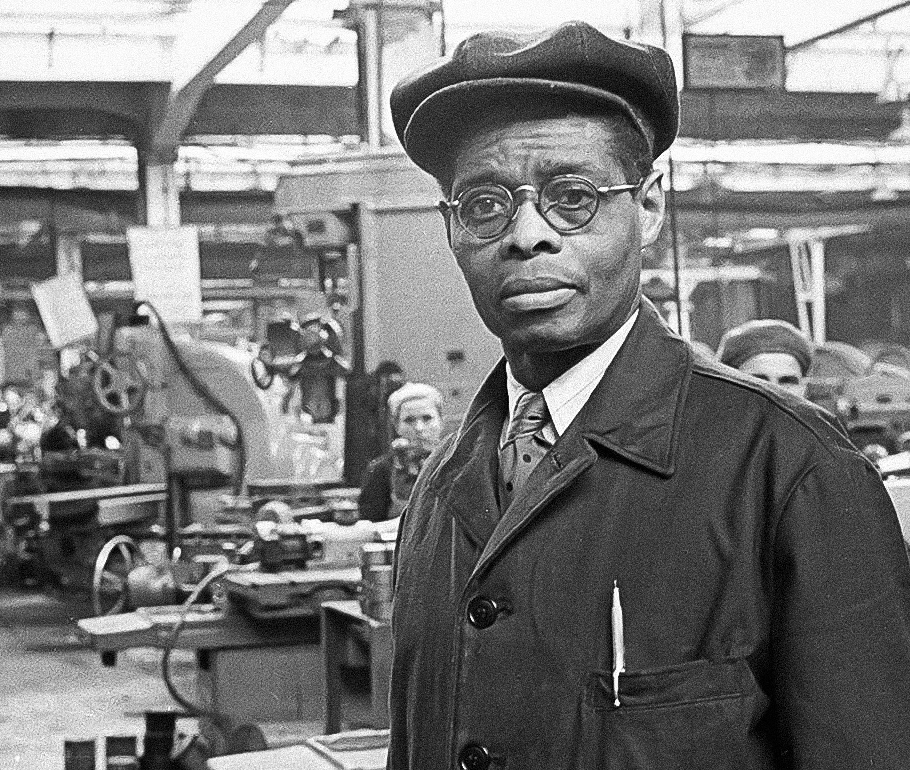
In 1930, unemployment and poverty spread across America like cancer. Lines at soup kitchens spilled out the doors and snaked around city blocks; the newly fired traded their homes for tent cities under bridges. On top of that, the Ku Klux Klan was on the rise, waging a campaign of terror against Black and immigrant communities. Even working-class whites with the audacity to unionize faced increasing backlash. That April, Robinson found himself in a meeting in a nondescript office building in the Detroit area. A deep review over the course of more than a year of US and Soviet news reports, government documents, accounts given by Robinson and other expats, and eyewitness accounts reveals the amazing series of events that began in that office.
Robinson sat across from an older, stout white man with a thick Russian accent who was a representative of Amtorg, Russia’s American trading firm. He’d come to the Ford Motor Plant, where Robinson was the only Black toolmaker, to recruit talented American workers to help push the USSR into the industrial age. This was part of a deal that Ford and the USSR struck the previous year — the Russians would buy cars and trucks, and in return, they’d get access to Ford’s engineers and executives. The Russians vetted hundreds of candidates, and Robinson drew their interest.
The old Russian said, “During the past week, I asked about your work, background and character. Everyone I have talked to is favorably impressed with you.” People tended to admire Robinson. “My boy doesn’t smoke, drink or gamble,” his mother would later tell Time Magazine. “He is a perfect gentleman and everybody who knows him loves him.”
The man laid out his offer: Robinson would not have to take the mandatory test the other — white — applicants had to take, because his skills were so advanced. His salary would be $250 a month, significantly more than the American average, with an additional $150 of his salary deposited into an American bank account, more than almost any Black worker could earn in America at that time. But he would have to move to the Soviet Union. He would not pay rent, and he’d get a housekeeper, a car and 30 paid vacation days a year. The offer was enough to leave someone in Robinson’s position speechless.
Despite the praise from the Amtorg representative, Robinson had reservations. From what he read in books and newspapers, Robinson considered Russia an agricultural wasteland, far behind industrialized America. He had hardly ever thought of the place.
On the other hand, Robinson longed for opportunity. He had started out sweeping the floors at the Ford plant, then eventually took courses at the factory’s technical school. It took him 18 months to become a toolmaker, even though he was talented enough to become an engineer. Mocked and belittled by his Ford supervisors, he overcame his hesitation about going to a different country. He accepted the offer, as did thousands of other American workers.
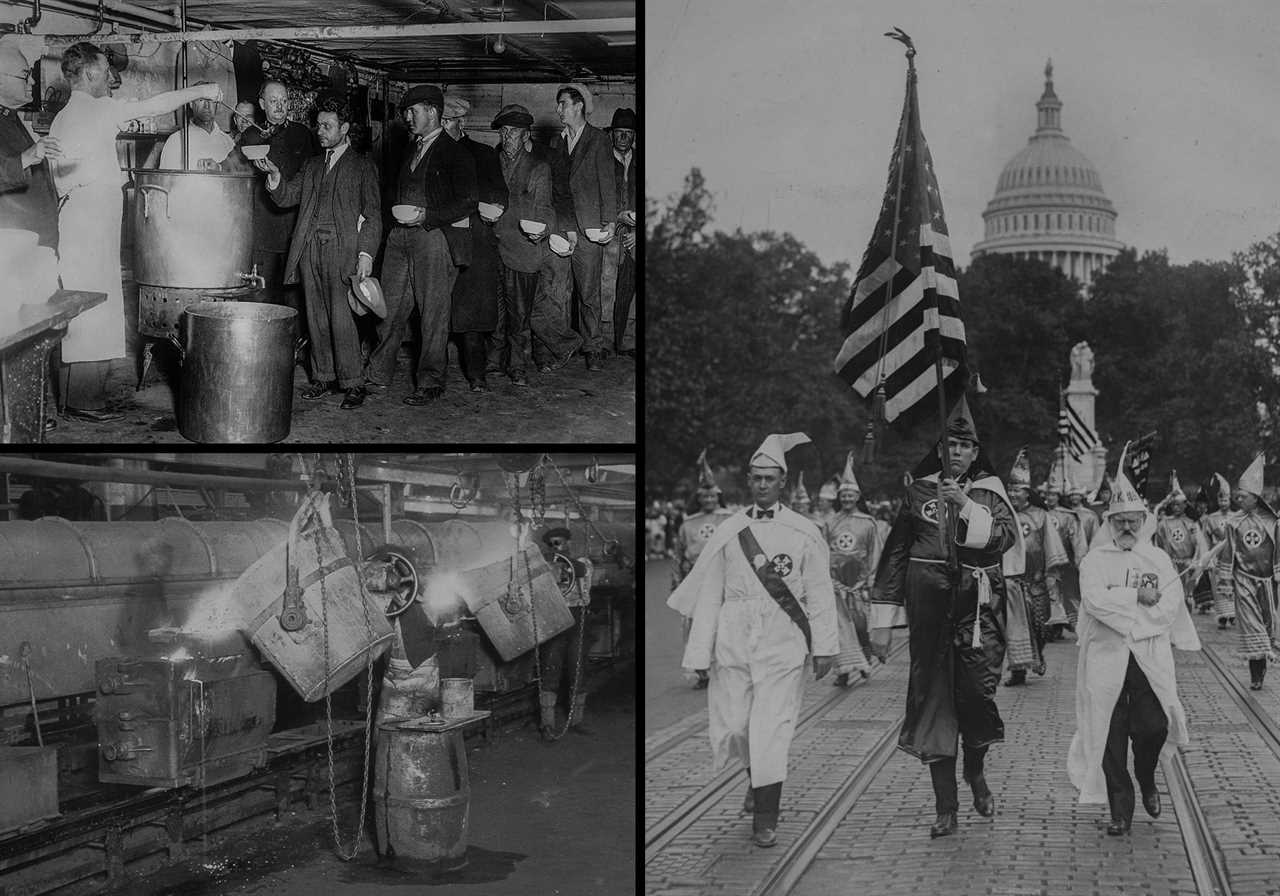
Robinson, as he recalled in later interviews and his memoir, Black on Red, arrived in Russia hoping it could really be an exemplar of equality. As a writer for Time magazine wrote around the same time, “nowhere else in the world is a Negro so pampered as in Russia.” There was a reason writers such as Langston Hughes, Claude McKay and musician Paul Robeson would end up making the journey to the Soviet Union and sending back glowing reports. Black people were migrating out of the South en masse, running away from racial oppression, and the Soviets, eager to spotlight the racist oppression powering the capitalist system, launched an extensive campaign to win them over with promises of professional, political and creative opportunities as well as financial incentives.
Vladimir Lenin had called for American Communists to recognize the contribution of Black workers to the economy. Under Stalin’s subsequent leadership, there was a push for recognition of the plight of the Black American in the South. Stalin even embraced the idea of supporting a nation within the United States just for Black Americans called the Black Belt Republic. Seeking a refuge from violent oppression, looking for something to give them hope, Black people increasingly turned to communism as a possible path towards equality.
On American soil, the Soviet Union funded a fight against systemic racist policies, viewing that as the easiest in-road to the Black community, which could in turn foment broader dissension against the U.S. government. The use of propaganda pamphlets had shown some efficacy — the most jarring featured an image of a Black body hanging from the Statue of Liberty. But their most powerful weapon in gaining Black membership was the use of legal defense in trials seen to be unwinnable. Around the time of Robinson’s residence in Soviet Russia, the Communist Party’s legal arm in the United States defended nine Black boys facing the death penalty after being railroaded for crimes they did not commit in Scottsboro, Alabama. Without the political baggage that weighed down American firms, Soviet-funded lawyers could fight the case even more aggressively than the NAACP, and attempted to tie racism to capitalism.
But Robinson did not care about the politics behind it all. He was amazed at how the culture in Russia contrasted with the open racism of the States. For starters, Russians did not even have an official word for “white” in terms of race. One day, as Robinson, took a boat ride up the Volga River, some white Americans on board complained about him occupying the same space as them. The ship’s captain announced that he would not segregate anyone based on race, explaining such a request was illegal under Soviet law. For a man who had experienced daily routines of racism, Robinson might as well have landed on a different planet.
He could get a bite to eat without being harassed and run out of restaurants. He was invited to parties, one in particular where he was shown how to “properly” drink tea. His status as a foreign specialist afforded him access to the higher echelons of the Communist Party’s leadership, who in turn offered him perks such as a weekend cottage in the countryside and entrance to the finest dining in the city. Robinson turned them down, though. He had no interest in being indebted to the Communist Party.
He openly danced with white women without fear of repercussions from Russian citizens, and over time, he made connections with a few of them on vacations in the country. But for the most part, the relationships were never too serious. Elsewhere in his social life, Robinson became friends with other notable Black individuals either living in or visiting Russia, including Hughes and Robeson. Robeson basked in his aura of celebrity at galas and parties the Communist Party threw in his honor. Robinson attended some of these gatherings, but he had no desire to be well known himself.
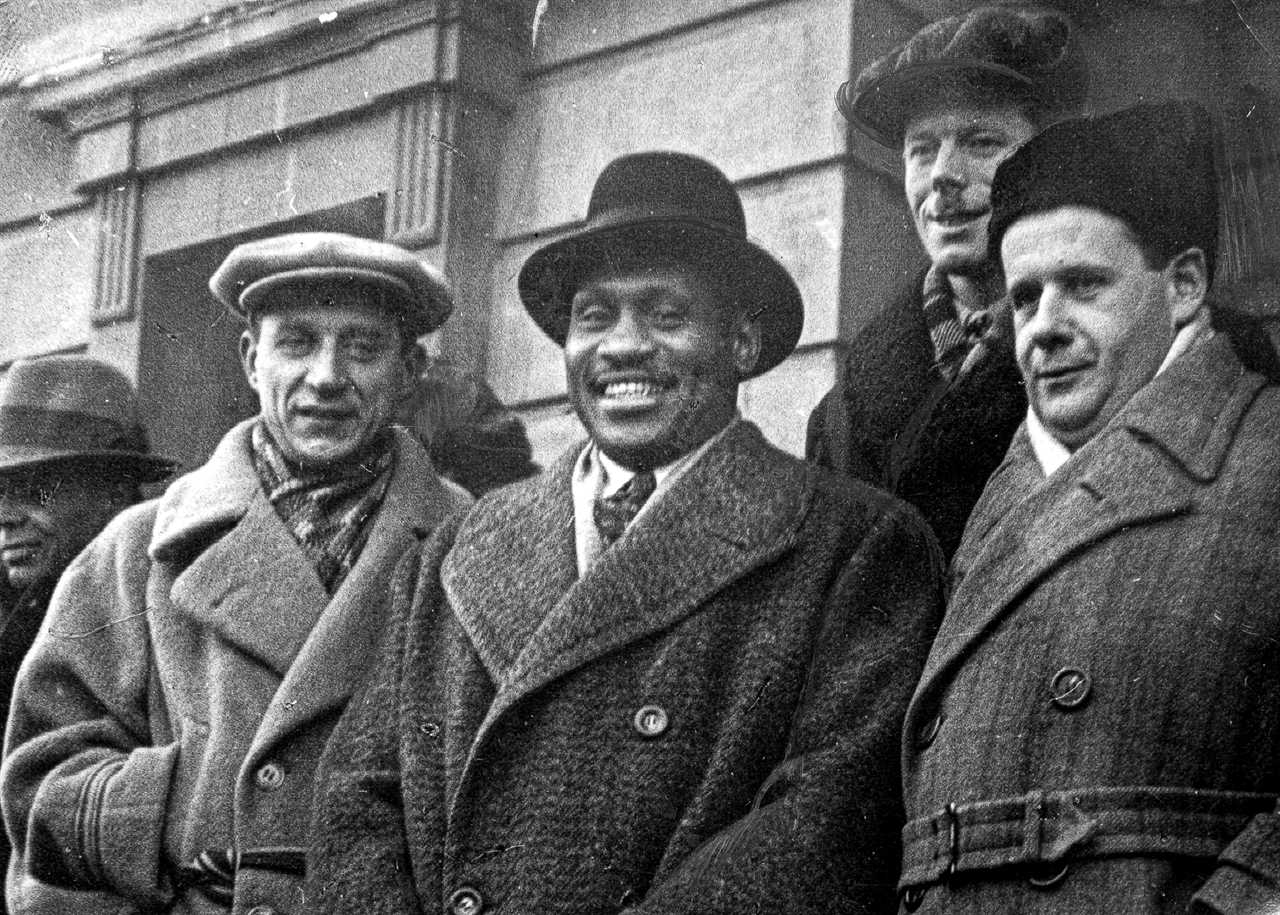
His priority was his new career at the Stalingrad Tractor Factory. The massive factory, as a contemporary Black expat named Harry Haywood observed, “stretched 15 miles along the Volga River,” making it the largest factory in Europe. Its design and function were based on American factories, reportedly copied from blueprints provided by Henry Ford himself. Years later, American photographer Robert Capa and novelist John Steinbeck, traveling together, would tour the factory, their guides emphasizing its roots in American enterprise.
It was in this setting that Robinson further cultivated his skills. When presented with a mechanical problem, Robinson was likely to be the first one in a room to find a solution. In one instance, a man with the last name of Gromov rushed to Robinson in need of dire help. Gromov was facing pressure from the government to finish designing a die-casting device in 10 days. Robinson drew a design in four hours, and it made the factory’s production much more efficient. In his time in Russia, as he later told the Boca Raton News, Robinson would go on to create at least 27 inventions.
Russia seemed to be a place where he could express himself freely, and he was finally allowed to be an engineer. There were even times when he and his white American co-workers shared genuine laughs.
Still, other Americans in his cohort kept up the racist harassment he had experienced at Ford. His white roommates complained about having to bunk with a Black man. In one case, the American co-workers coached their Russian-speaking girlfriends into calling him a hateful slur as he walked through a lobby.
Robinson kept his head down and focused on the work.

After the warning from his sympathetic co-worker put him on alert that fellow Americans planned to attack him, Robinson needed to think of a solution to an overwhelming problem. In some ways it was similar to his daily life: breaking things down to their finest components and rebuilding them to be better. But how do you counter a threat that’s both conspicuous and invisible?
In order to outmaneuver his enemies, he needed to identify the plotters, and to do that he had to draw them out from the larger group. Robinson went to the river and sat on the sandy embankment the next day. About 10 yards away, several Americans glared at him, any of whom could be those scheming against him. For five days he kept a watchful eye on the white Americans and stayed far from the edge of the beach. He clung to his Russian coworkers. When they went to the beach, he went. When they left, he left. Each passing day those 10 yards of distance between him and his would-be killers got shorter and shorter, shrinking his safety net. But after a week and a half, without succeeding in chasing him away, they seemed to have given up.
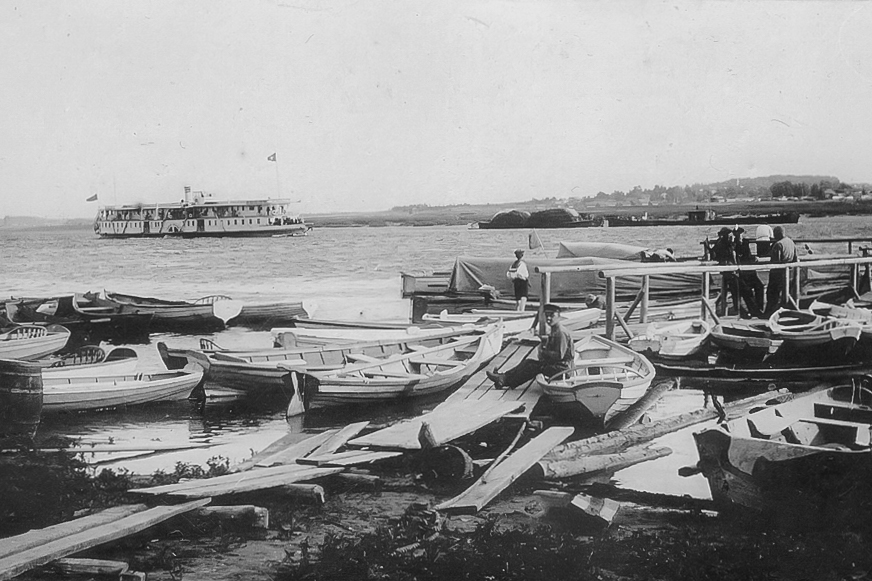
On the night of July 24, 1930, while exiting the factory dinner hall, he heard footsteps behind him, and someone called him the N-word.
He spun around and saw two coworkers coming towards him, Lemuel (sometimes called Herbert) Lewis and William Brown. It was Lewis who had hurled the racial epithet, and both were part of the cabal that had reportedly planned his murder.
Lewis came closer. “How’d you get here?”
“Same way you did,” said Robinson.
Lewis told Robinson to remember his place, calling him a “black dog.” The two issued a warning to him: Leave in 24 hours — or else.
Where to sit, where to live, where to eat, whom to love, how to feel, where to go and not go. Robinson was tired of taking orders from white authorities in the States. Now that he had freed himself from those restrictions, he was not going to lose his chance at becoming a top engineer.
Outside the factory, he stood his ground against Lewis and Brown. Robinson called Lewis a bastard and warned that if he were to be drowned in the Volga, he would take a white man with him.
They ran at him. As reported by witnesses, Robinson picked up a stone to defend himself. They retreated, but when Robinson turned to walk away, Lewis ran and punched him in the back of the head, knocking off his glasses.
Robinson lunged back, but only succeeded in pulling Lewis down with him. Lewis punched him while Brown held Robinson’s arms back. “Something inside me exploded,” he wrote later in his memoir, and he managed to sink his teeth into Lewis’ neck.
Brown tried to pry Robinson away, but his teeth held tight until skin broke and the coppery taste of blood sputtered into his mouth. A group of men reportedly watched and laughed, but when Lewis’ cries started, they stepped in. The Russians and Americans struggled to untangle the men, but once they were free, Lewis and Brown ran off shaken, blood spreading down Lewis’ neck and dotting the floor.
Robinson said nothing as he walked back to his apartment, inwardly hysterical but outwardly stoic. He had survived the attack, but in the States, the repercussions for Black people who defended themselves against white men were typically arrest or death by mob. He had every reason to stay awake the whole night, waiting for approaching footsteps, praying he wouldn’t drown at the bottom of the Volga, just as many of his people back in the United States would disappear into the bottom of the Mississippi. Night turned to day. Robinson did not want to report the attack. The authorities came to his door anyway. They brought him down to the police station, where he answered the officers’ questions. When he went home, it all seemed to be over. The authorities did not dig any further.
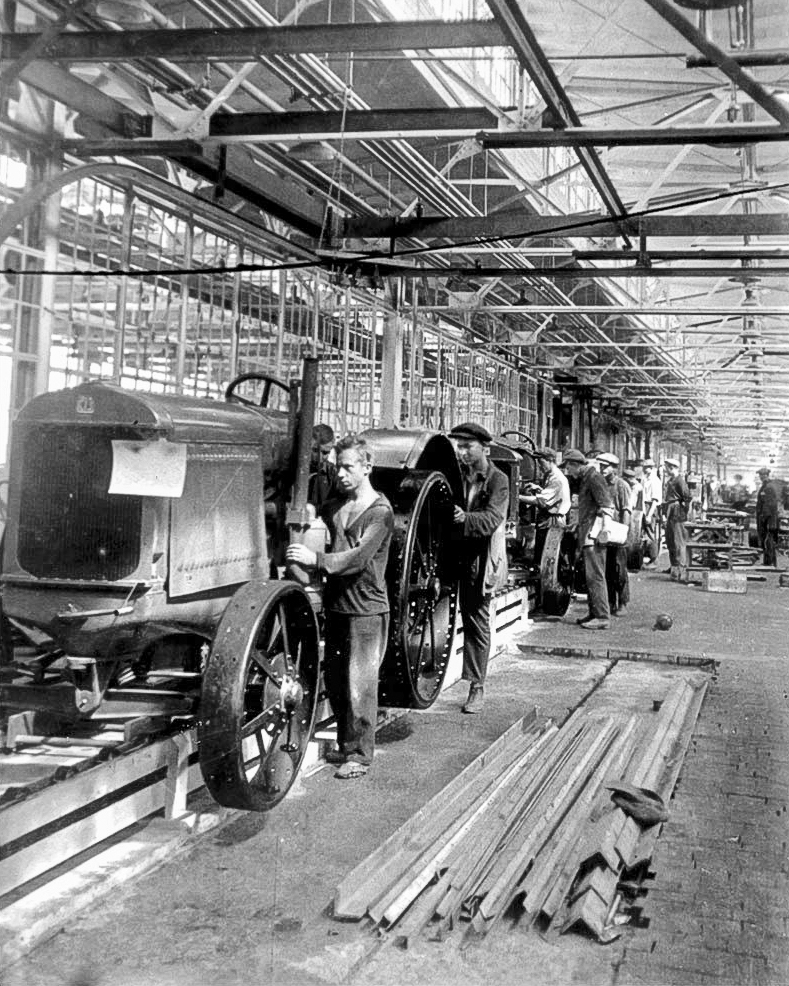
But even though there had not been an arrest — on either side — it was about to become an international incident. Details leaked outside the parties involved and led to sympathetic media coverage in Russia and hostile coverage in the United States. An American worker wrote a letter that was published in the Detroit News, excusing the assault by pointing out the foolishness of hiring Robinson in the first place:
“There is a colored fellow in our crowd who just came in. Whoever had the nerve to hire him and send him here had very little brains for you can imagine what a life he will live over here being the only one,” he wrote. Another coworker of Robinson’s complained to an American reporter that there was an effort to force the rank-and-file into “something no white American will stand for: social equality with the colored race.”
But Russians reacted differently, prompting what a United Press wire service columnist called “a hurricane of resolutions from factories throughout the country.” A Black worker at another Soviet factory spoke out against the results of a “reactionary capitalist education which sets race against race, color against color.” A Russian paper, Trud, published a story that promised that Russia would not “allow the ways of bourgeois America in the USSR.” The papers harped on the fact that the attackers were American and emphasized that Robinson was Black and from the South. Robinson was not from the South, and he had family roots in a variety of places other than the States, including Jamaica and Cuba; but the Russian public correlated the American South with hate, intolerance and white capitalist tyranny.

Robinson’s Soviet co-workers in the factory, as well as supporters across the Soviet Union, called for justice. “The Negro worker is our brother like the white American worker,” read a statement released to the public. “American technique: yes!” went one rallying cry, “American prejudice: no!”
The outrage led to the formation of a prosecution panel made up of nine elected workers of different backgrounds, two of whom were women. The result was a trial conducted not by the government but rather by representatives of the factory acting as a quasi-judiciary — a procedure made possible by the Soviet emphasis on the power of workers. Whether driven by values or propaganda, the trial was not really about Robinson, nor even about Lewis and Brown. It became about the USSR versus America: communism versus capitalism. The panel’s duty was to conclusively prove the attack on Robinson was racially motivated, which in turn would be an indictment of American culture and a distraction from the faults of the USSR, including the tragic consequences of Stalin’s rapid collectivization of agriculture — widespread famine and increasingly brutal repression as the new dictator consolidated power.
On August 22, 1930, the makeshift courtroom in the Tractor Works Club buzzed with excitement with more than a thousand people in attendance. They were all there to see Robinson, who sat amid supporters, uncomfortable with his overnight celebrity. In the streets, passersby praised Robinson for his heroism and apologized for what happened to him. A teacher approached him before the trial on his walk to the front of the courtroom and pleaded with him to come speak to her 7-year-old students. Robinson was stunned, but he walked over to the children and shook their hands. Rallies in support of Robinson were held in public spaces, decrying the evils of American racism. In the factory, Robinson was greeted with nods and words of approval by his Russian cohorts.
Back in the States, there were powerful people who had reason to try to turn the tide against justice. The acting chief of Eastern European Affairs for the State Department sent information to the Bureau of Investigations (the forerunner of the FBI), led by a 35-year-old J. Edgar Hoover. If Soviet officials saw a chance to elevate Robinson, Americans saw an opportunity to tear him down. An assortment of surviving documents and correspondence held in the National Archives reveals a plot to intervene by the diplomats, who sought evidence that could depict Robinson as an anti-American subversive.
The clock was ticking. If Hoover’s agents could find or manufacture dirt on Robinson, they could leak information to try to sway the public, both Soviet and American. Congress was gearing up for hearings about the dangers of communism, which included discussion of Robinson’s case. The U.S. government had not yet opened an embassy in Moscow, but declassified State Department documents reveal that American diplomats in Latvia, who handled diplomatic matters with the Soviet government, insisted that the trial for “beating an American Negro” was engineered “for communist and revolutionary propaganda purposes” rather than genuine justice, implicitly mocking the “determination of Soviets to have no race prejudices.” One of the envoys dismissed as a “comic interlude” a statement by a man sympathetic to the attackers that all Blacks “should be lynched.”
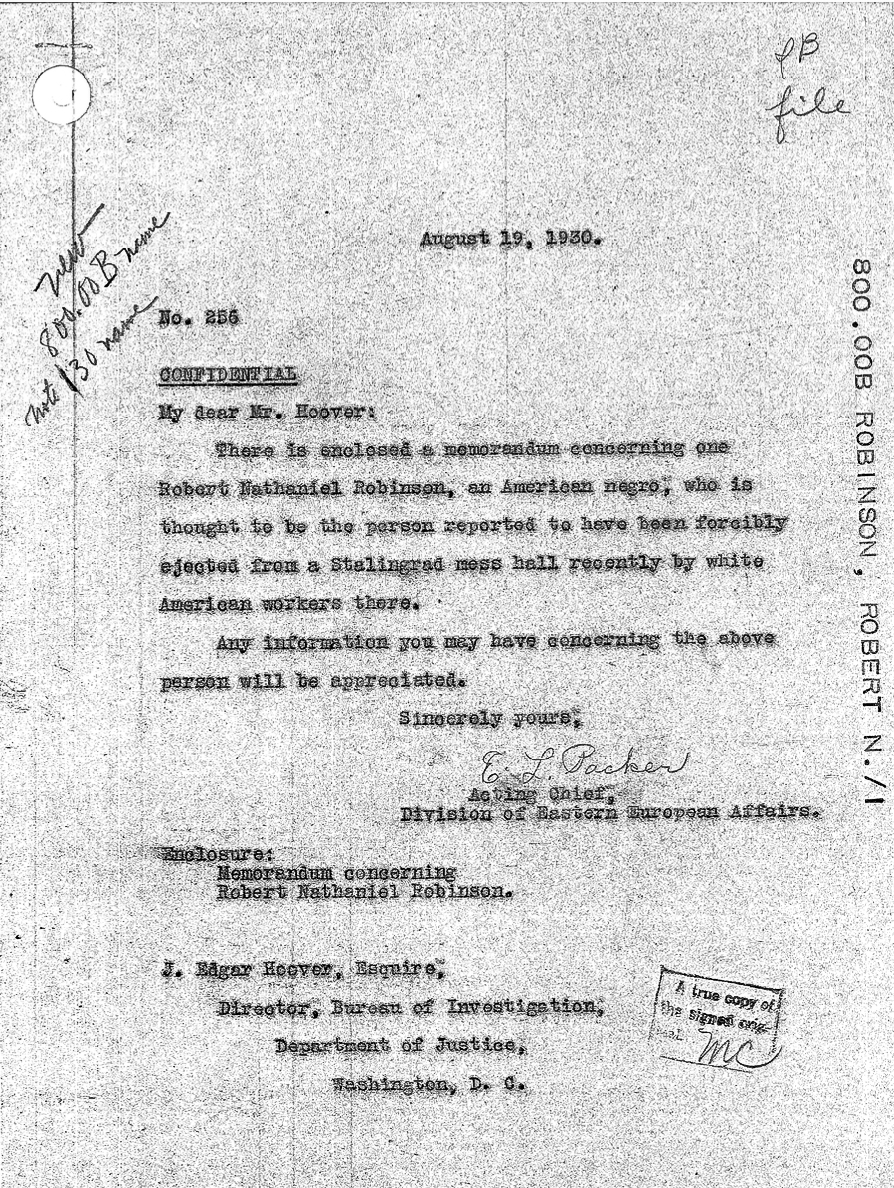
Meanwhile, Soviet newspapers continued to frame the attack on Robinson as an attack on the Soviet way of life, and in turn, a capitalist attack on the working man. But the Party carefully shielded the fact that had Robinson fought back against his attackers, casting him as a pure victim.
Meanwhile, Lewis and Brown’s defense, provided by the Soviets, framed them as brainwashed by American capitalist racism, which resonated with the Soviet public. Lewis was urged to write an apology to the Soviet proletariat for failing to understand the consequences of national and racial dissension. But this fell flat, since it was discovered that his response was crafted by others, and prior to that, that a line had been scratched out. When later questioned by a journalist as to why, Lewis’ explanation for the change was that the omitted phrase had been a “direct apology to the ni----.”
“I did not think I would be brought to trial,” Lewis reportedly commented. “In America, incidents with negroes — this is simply considered a street fight.”
“In America,” Brown said, “this would be treated as a joke.”
Brown and Lewis were outgunned from the outset, though, with witnesses across various spectrums coming to Robinson’s defense. Lewis in particular became the focal point of the factory court’s ire. Brown pointed the finger at him, trying to distance himself. Lewis was described by witnesses as a “drunken rowdy” and a fascist.
When it was his turn on the stand, Robinson had to be exceedingly careful. He did not want to vocalize politics he did not believe in, even though he knew that Blacks who failed to support the party could face consequences. The Communist Party power structure that protected them could be turned against them. Singer Paul Robeson ultimately would be exiled and blacklisted in the USSR after questioning domestic policy on Jews. No matter how he handled himself at trial, Robinson could expect aftershocks from either American or Russian operatives. He defended his actions but managed to avoid articulating a political framing of his situation.
After six days of speeches and witness testimonies, the verdict was handed down: Lewis and Brown were sentenced to two years of imprisonment. One of the nine members of the prosecution panel summarized their position: The perpetrators of the attack “contaminated” their community. However, their sentences were commuted to 10 years of exile from the Soviet Union, because they had been “inoculated with racial enmity by the capitalistic system.” In the eyes of the Russian public, there was no harsher penalty than banishment.
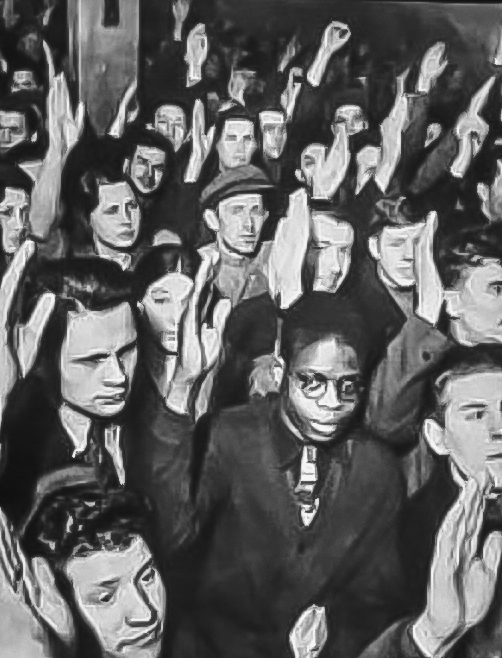
An American living in the Soviet Union who observed the trial recalled that “the Russian workers were so indignant at white men treating a fellow worker in that fashion simply because of his race that they demanded their immediate expulsion from the Soviet Union.” America was rattled by the Great Depression, and to Soviet citizens, a forced return there amounted to being abandoned in a wasteland of unemployment and sparse food.
American press coverage in the wake of the verdict fractured. Several mainstream outlets exhibited less interest in the outcome than they had in the trial itself, while multiple Black newspapers commended the stand against racism.
Robinson was offered a position elsewhere but decided to stay at the Stalingrad Tractor Factory. His growing fame from the trial may have been undesired, but it also empowered him. The public focus on Robinson seemed to stall further attempts at sabotage by American intelligence operatives, who would not want attention on their tactics.

Though Robinson prevailed in court in what became known as the Stalingrad Incident, the machinations for and against him gestured at the hidden agendas in play. Just as the American intelligence community explored ways to discredit Robinson, Russia also manipulated the roles and reputations of some of the Black people they recruited. When American reporter Daniel Schorr, who visited Russia in the 1940s, tracked down Robinson, he learned the engineer worried he had become a “token Black.” Even his romantic life was increasingly orchestrated. A married woman tried to seduce him before he found out she was a spy for the Communist Party. Robinson grew to adore another woman, named Nyura. They would sit on the beach or go for walks. Abruptly, she wrote him a letter saying they should stop speaking. Robinson said he felt the invisible hand of the Party meddling in his life.
A contemporary Black American working in Russia believed some of Robinson’s technological and engineering innovations were ultimately incorporated, presumably without Robinson’s knowledge, into Russia’s triumph of the space race, Sputnik. Indeed, the intrusion of politics on Robinson’s time in Russia would only increase, and his aim to achieve his potential while avoiding being used as a tool in international conflict would grow even more complicated.
Eventually, Robinson decided to return to the United States — but he found that a homecoming would be anything but easy. Eleven years after relinquishing his U.S. citizenship, in 1945, Robinson applied for a visa to visit his ailing mother back in America, but the Soviet regime denied his request, and he spent the period from roughly 1945 to 1973 trying to find a way out of the country. In 1974, he made his way to Uganda, and finally returned to the U.S. in 1980. In 1986, his citizenship was restored.
Many other Americans who tried to make it out ended up dead, shot by the regime or worked to death in labor camps as the Soviet regime became mired in paranoia, conducted waves of purges and suspicion of foreigners reached a fever pitch. In 1937, Lovett Fort-Whiteman, the leader of the communist American Negro Labor Conference who had been recruited by the Soviet Union and worked in Moscow for nine years, disappeared after seeking permission to return to the U.S.; he was arrested for allegedly making anti-Soviet statements and died in a labor camp in 1939.
With anti-communist sentiments riding high in America, the U.S. embassy in Moscow, which opened in 1933, was little help. It often turned Americans who wanted to return home away over trivialities — they lacked the meager sums of American currency required to renew their passports, or didn’t have up-to-date photos for identification. Even visiting the embassy could prove dangerous: Soviet agents lurking outside the gates disappeared young Americans like Marvin Volat, who moved to the Soviet Union at age 20 to study violin. He was arrested outside the U.S. embassy and charged with counter-revolutionary activity and espionage. He died in a labor camp the next year, at age 28.
Even after his return to the U.S., Robinson lived in fear of Soviet retaliation. At age 81, in 1989, Washington Post","link":{"target":"NEW","attributes":[],"url":"https://www.washingtonpost.com/archive/local/1989/02/16/a-reading-on-a-saga-in-the-soviet-union/e18d5e52-c0f4-44d2-a6e3-f02d70074379/","_id":"00000186-3b05-d69d-ab96-ff776bfc0000","_type":"33ac701a-72c1-316a-a3a5-13918cf384df"},"_id":"00000186-3b05-d69d-ab96-ff776bfc0001","_type":"02ec1f82-5e56-3b8c-af6e-6fc7c8772266"}">he told the Washington Post: “Even now I have to be careful, because so many people do not understand the Russian psychology: that once you have offended the Russians you are never forgiven. Never forgiven.”
Two years later, in 1991, the Soviet Union collapsed.
----------------------------------------
By: Danny Cherry Jr.
Title: ‘The Americans Got Together and Decided to Drown You in the River’
Sourced From: www.politico.com/news/magazine/2023/02/10/stalingrad-incident-soviet-union-00080983
Published Date: Fri, 10 Feb 2023 04:30:00 EST






